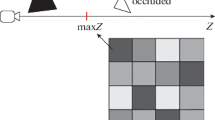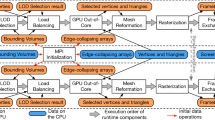Abstract
A one-pass rendering scheme of 3D dynamic scenes using modern graphics processing units (GPUs) and graphical interfaces is considered. This scheme uses the following methods and techniques: frustum culling, hardware occlusion queries, fragmentation, and caching of command buffers. These methods require significant computational resources, and the amount of work on the stages of graphics pipeline depends on their results. For efficient rendering, the balanced use of resources during the pipelined processing and transferring graphics data is important. A performance model of the graphics pipeline as applied to rendering 3D dynamic scenes that makes it possible to estimate the required resources, depending on the selected base methods and characteristics of the scene being rendered is proposed. In distinction from the existing methods and models, the proposed model allows one to calculate the cost of composing command buffers using various recording techniques, calculate the cost of transferring, executing, and loading the results of hardware occlusion queries. Formulas for calculating the frame rendering time depending on the number of occlusion queries are derived. A method for estimating the number of hardware occlusion queries needed for efficient rendering of dynamic scenes is proposed. Computational experiments demonstrating the relevance of the proposed model and the efficiency of the developed method for rendering large dynamic scenes are carried out.



Similar content being viewed by others
REFERENCES
Cohen-Or, D., Chrysanthou, Y.L., Silva, C.T., and Durand, F., A survey of visibility for walkthrough applications, IEEE Trans. Visualization Comput. Graph., 2003, vol. 9, no. 3, pp. 412–431.
Airey, J., Increasing Update Rates in the Building Walkthrough System with Automatic Model-Space Subdivision and Potentially Visible Set Calculations, PhD thesis, University of North Carolina, Chappel Hill, 1991.
Teller, S.J., Visibility Computations in Densely Occluded Polyhedral Environments. PhD thesis, University of California at Berkeley, 1992.
Luebke, D. and Georges, C., Portals and mirrors: Simple, fast evaluation of potentially visible sets, Proc. of the 1995 Symposium on Interactive 3D Graphics, 1995, pp. 105–106.
Durand, F., Drettakis, G., Thollot, J., and Puech, C., Conservative visibility preprocessing using extended projections, Proc. of the 27th Annual Conference on Computer Graphics and Interactive Techniques, 2000, pp. 239–248.
Greene, N., Kass, M., and Miller, G., Hierarchical Z‑buffer visibility, Proc. of the 20th Annual Conference on Computer Graphics and Interactive Techniques, 1993, pp. 231–238.
Bittner, J., Havran, V., and Slavik, P., Hierarchical visibility culling with occlusion trees, Proc. of the Computer Graphics International, Proc. of the Computer Graphics International, 1998, pp. 207–219.
Coorg, S. and Teller, S., Temporally coherent conservative visibility, Comput. Geom., 1999, vol. 12, nos. 1–2, pp. 105–124.
Coorg, S. and Teller, S., Real-time occlusion culling for models with large occluders, Proc. of the 1997 Symposium on Interactive 3D Graphics,1997, pp. 83–90.
Hudson, T., Manocha, D., Cohen, J., Lin, M., Hoff, K., and Zhang, H., Accelerated occlusion culling using shadow frustra, IEEE Comput. Graph. Appl., vol. 4, no. 10, 1984, pp. 15–24.
Glassner, A.S., Space subdivision for fast ray tracing, IEEE Comput. Graph. Appl., 1984, vol. 4, no. 10, pp. 1–10.
Pharr, M., Jakob, W., and Humphreys, G., Physically Based Rendering: From Theory to Implementation, Morgan Kaufmann, 2016, 3rd ed.
Sudarsky, O. and Gotsman, C., Dynamic scene occlusion culling, IEEE Trans. Visualization Comput. Graph., 1999, vol. 5, no. 1, pp. 13–29.
Morozov, S., Semenov, V., Tarlapan, O., and Zolotov, V., Indexing of hierarchically organized spatial-temporal data using dynamic regular octrees, Lect. Notes Comput. Sci., 2018, vol. 10742, pp. 276–290.
www.khronos.org/registry/OpenGL/extensions/NV/ NV_occlusion_query.txt. Accessed on 26.08.2020.
Bittner, J., Wimmer, M., Piringer, H., and Purgathofer, W., Coherent hierarchical culling: Hardware occlusion queries made useful, Comput. Graph. Forum, 2004, vol. 23, no. 3, pp. 615–624.
Mattausch, O., Bittner, J., and Wimmer, M., CHC++: Coherent hierarchical culling revisited, Comput. Graph. Forum, 2008, vol. 27, no. 2, pp. 221–230.
Guthe M., Balázs Á., and Klein R., Near optimal hierarchical culling: Performance driven use of hardware occlusion queries, Proc. of the 17th Eurographics Symposium on Rendering, 2006, pp. 207–214
Gonakhchyan, V.I., Efficient command buffer recording for accelerated rendering of large 3D scenes, Proc. of the 12th International Conference on Computer Graphics, Visualization, Computer Vision and Image Processing, 2018, pp. 397–402.
Funkhouser, T.A. and Sequin, C.H., Adaptive display algorithm for interactive frame rates during visualization of complex virtual environments, Proc. of the 20th Annual Conference on Computer Graphics and Interactive Techniques, 1993, pp. 247–254.
Wimmer, M. and Wonka, P., Rendering time estimation for real-time rendering, Proc. of the 14th Eurographics Workshop on Rendering, 2003, pp. 118–129.
Weisstein, Eric W., Least squares fitting – logarithmic. From MathWorld, A Wolfram Web Resource. URL: https://mathworld.wolfram.com/LeastSquaresFittingLogarithmic.html. Accessed on 26.08.2020.
Chernyak, A.A., Chernyak, Zh.A., Metelsky, Yu.M., and Bogdanovich, S.A. Optimization Methods: Theory and Algorithms, 2nd ed., Yurait, 2017 [in Russian].
Author information
Authors and Affiliations
Corresponding author
Additional information
Translated by A. Klimontovich
Rights and permissions
About this article
Cite this article
Gonakhchyan, V.I. Performance Model of Graphics Pipeline for a One-Pass Rendering of 3D Dynamic Scenes. Program Comput Soft 47, 522–533 (2021). https://doi.org/10.1134/S0361768821070057
Received:
Revised:
Accepted:
Published:
Issue Date:
DOI: https://doi.org/10.1134/S0361768821070057




